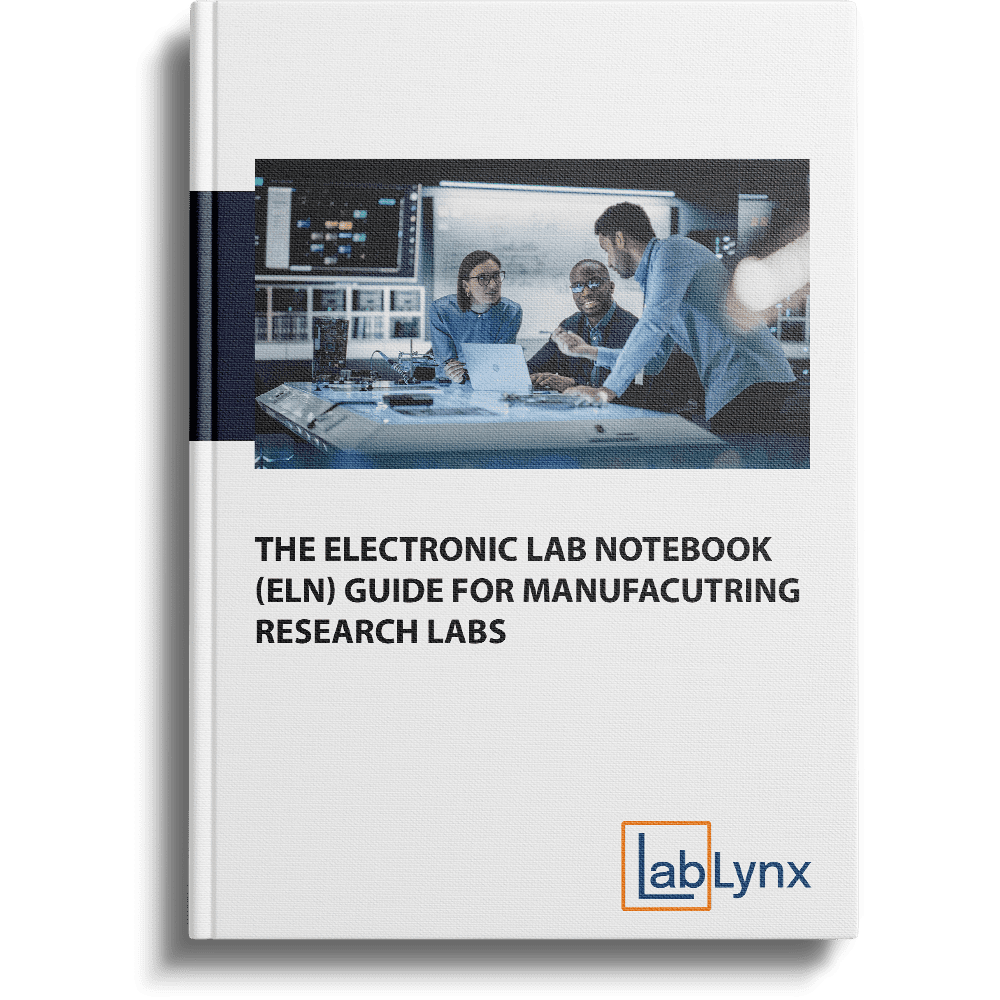Download Book For Free!
Resource Download
"*" indicates required fields

In today’s competitive manufacturing landscape, the ability to innovate quickly—while maintaining rigorous quality and compliance standards—is essential. Research and development (R&D) teams working in manufacturing environments face mounting pressure to accelerate product development, reduce errors, and collaborate seamlessly across departments and sites. With so many moving parts, how do forward-thinking labs manage complex data and ensure consistency from concept to production?
Enter the Electronic Laboratory Notebook (ELN)—a powerful digital tool transforming how manufacturing research labs work, collaborate, and document their findings.
The ELN Guide for Manufacturing Research Labs explores how ELNs are shaping the future of manufacturing R&D. From streamlining formulation tracking to facilitating cross-functional collaboration, this comprehensive guide is built for teams ready to replace outdated, manual processes with a secure and scalable digital solution.
Why Manufacturing R&D Labs Need ELNs More Than Ever
Unlike academic labs or contract testing environments, manufacturing research labs operate at the intersection of innovation and scalability. Every formula, process improvement, or material substitution has downstream implications for production, quality control, and regulatory compliance.
Unfortunately, traditional documentation methods—like spreadsheets, shared drives, or paper lab notebooks—can’t keep up with the demands of fast-paced manufacturing environments. These systems often lead to miscommunication, version control issues, and delays in transferring knowledge from R&D to production teams.
Electronic Lab Notebooks offer a modern alternative. ELNs standardize how data is captured, allow for real-time collaboration, and create a secure, centralized environment where research findings are always accessible, reproducible, and ready to scale.
What This Guide Covers
The ELN Guide for Manufacturing Research Labs is structured to give you a deep, practical understanding of how ELNs support the full research lifecycle in manufacturing environments. Here’s a breakdown of the key topics explored inside:
1. How ELNs Fit into the Manufacturing Research Workflow
The guide opens with a detailed look at the documentation challenges faced by R&D teams working in manufacturing. These include fragmented communication between labs and production, inconsistent experiment documentation, and difficulties in aligning test results with compliance requirements.
You’ll learn how ELNs serve as a central hub for R&D activities—connecting data, people, and processes across development cycles while ensuring quality and traceability at every step.
2. Essential ELN Features for Manufacturing Labs
Not all ELNs are designed with manufacturing in mind. This section outlines the most important features to look for when evaluating an ELN for R&D use in a manufacturing setting, including:
- Custom experiment templates for formulations, pilot runs, and process tests
- Batch tracking and material specifications
- Integration with production data or ERP systems
- Controlled workflows and approval chains
- Version control, electronic signatures, and audit logs
You’ll see how each feature plays a role in reducing friction between departments and improving the speed and reliability of product development.
3. Challenges Manufacturing Labs Face—and How ELNs Solve Them
This section explores real-world challenges manufacturing research teams often encounter, such as:
- Difficulty tracking changes across formula revisions
- Inconsistent testing documentation between sites
- Delays transferring R&D data to production or QA teams
- Complications during internal audits or client reviews
You’ll learn how ELNs solve these problems by centralizing test data, automating version tracking, and enforcing standard operating procedures across all users and locations.
4. Planning a Successful ELN Rollout
Introducing an ELN isn’t just an IT project—it’s a cultural shift for your lab. This section offers a step-by-step framework to help you evaluate your current workflows, engage stakeholders, define key requirements, and roll out your ELN in a way that drives adoption and long-term success.
You’ll also learn how to start with a pilot project, create a training plan, and set measurable goals so your team can quickly see the value of the system in action.
5. Building a Scalable, Sustainable R&D Infrastructure
The final section looks to the future—showing how ELNs support ongoing growth and innovation in manufacturing labs. Whether you’re developing new product lines, expanding R&D operations across facilities, or undergoing digital transformation, an ELN provides the foundation to scale without sacrificing accuracy or compliance.
This section shows how teams use ELNs to align R&D with production, accelerate tech transfer, and reduce the time from bench to market.
Who Should Read This Guide?
This resource was developed with manufacturing-focused R&D professionals in mind. It’s especially valuable for:
- Innovation and formulation teams working in industrial, chemical, or consumer goods manufacturing
- Lab managers and directors looking to modernize operations
- Quality assurance and regulatory teams overseeing research documentation
- Engineering teams focused on pilot testing and process optimization
- Any organization aiming to streamline collaboration between R&D, production, and quality
Why This Guide Matters
Innovation without documentation is just a good idea that never scales. In manufacturing, a breakthrough in the lab must be backed by a rock-solid, traceable record if it’s ever going to reach production—and meet compliance demands.
This guide offers a practical, real-world approach to understanding how ELNs fit into the unique workflows of manufacturing research labs. Whether you’re trying to streamline collaboration, improve compliance readiness, or simply speed up development, this resource helps you explore your options with clarity and confidence.
